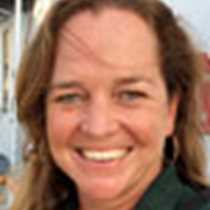Sailing through the Baltic Sea
After several very busy days exploring three of the spectacular cities that border the Baltic Sea, as well as some of the islands in the area, we were all ready for a nice relaxing day at sea. We traveled in the wake of centuries of trade, from Gdansk in Poland all the way to Riga in Latvia – a total of 330 nautical miles during which we experienced calm sailing and sunny skies.
We spent the day relaxing, catching up on journals and books, and sorting through the overload of experiences and images that we have received the last few days. Many of us took advantage of free time to visit our Captain and officers in the bridge, who delighted in showing us the instruments that enable the National Geographic Endeavour to navigate safely though these waters, getting us to our destinations in great time. It was particularly surprising to check the depth sounder, and find that we were in constantly shallow waters - the Baltic Sea has an average depth of just over 150 feet! It is a sea that has very little connection with other seas so very moderate mixing occurs, as a result of which it is practically freshwater.
The time at sea allowed us to learn more about the area we are exploring through a series of presentations from our staff: Tom Ritchie gave an introduction to the geography, geology and ecology of the Baltic Sea, David Barnes looked at some of the earlier movements of people in the Baltic during a presentation entitled “The Age of the Vikings”, and finally Sharon Grainger opened our eyes and minds to the beautiful world of amber, of which the largest beds in the world are found in the Baltic and which has been a major trade item for centuries.
A day that, though restful, managed to fly by as we were kept busy; evening coming along gradually as our anticipation for the following day’s exploration of the fascinating and relatively mysterious Riga increased rapidly.
After several very busy days exploring three of the spectacular cities that border the Baltic Sea, as well as some of the islands in the area, we were all ready for a nice relaxing day at sea. We traveled in the wake of centuries of trade, from Gdansk in Poland all the way to Riga in Latvia – a total of 330 nautical miles during which we experienced calm sailing and sunny skies.
We spent the day relaxing, catching up on journals and books, and sorting through the overload of experiences and images that we have received the last few days. Many of us took advantage of free time to visit our Captain and officers in the bridge, who delighted in showing us the instruments that enable the National Geographic Endeavour to navigate safely though these waters, getting us to our destinations in great time. It was particularly surprising to check the depth sounder, and find that we were in constantly shallow waters - the Baltic Sea has an average depth of just over 150 feet! It is a sea that has very little connection with other seas so very moderate mixing occurs, as a result of which it is practically freshwater.
The time at sea allowed us to learn more about the area we are exploring through a series of presentations from our staff: Tom Ritchie gave an introduction to the geography, geology and ecology of the Baltic Sea, David Barnes looked at some of the earlier movements of people in the Baltic during a presentation entitled “The Age of the Vikings”, and finally Sharon Grainger opened our eyes and minds to the beautiful world of amber, of which the largest beds in the world are found in the Baltic and which has been a major trade item for centuries.
A day that, though restful, managed to fly by as we were kept busy; evening coming along gradually as our anticipation for the following day’s exploration of the fascinating and relatively mysterious Riga increased rapidly.



